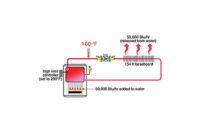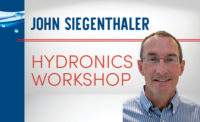Do you ever feel there are just too many pipes, circulators, controls and other gadgets in the hydronic systems you install? Why is it that many well-organized two-dimensional schematics — systems that look so good on paper — often turn into a tangled array of hardware when installed?
Many of us have seen “prize winning” hydronic systems displayed in trade journals and other publications over the years. Most of these systems are one-of-a-kind installations. With proper design, documentation and scheduled maintenance, they can serve their owners well. Take away any of these requisites and you have a very expensive collection of hardware that nobody seems to understand or is willing to service.
The latter scenario is a serious issue. The last thing our industry needs is for the average consumer to think hydronic heating has to be complex to be correct, or that hydronic systems that go beyond a boiler, a circulator and a series loop of fin-tube baseboard cannot be easily maintained by a reasonably competent HVAC technician.
What follows are suggestions on ways to simplify residential hydronic heating systems. The objective is to trim away at design details and hardware that, in many cases, doesn’t need to be present for the system to deliver efficient operation and superior comfort.
Less multi-temperature systems
A common situation in planning radiant panel heating systems is the need for multiple supply water temperatures. An example would be a system that heats the basement slab as well as the wood-framed floor areas of a house. The latter type of floor heating is often accomplished using a tube & plate system installed above or below the subflooring.
A common approach is to set up a separate mixing assembly for each type of radiant panel construction. Some designers will specify separate mixing assemblies for every area with different types of floor covering (e.g. ceramic tile versus padded carpet). Sometimes a separate mixing assembly is also specified on a floor level basis, even when the water temperature requirements of the panels being supplied are the same.
I’ve designed residential systems with three different mixing assemblies, and I’ve seen systems having at least five independent mixing assemblies. Do these systems work? Yes. Is this complexity necessary? Not necessarily.
The following procedures can be used during the design process to help decide if multiple water temperatures are needed:
- Add up all the circuit supply water temperature calculated for design load conditions;
- Calculate the average of these supply temperatures;
- If the supply temperature for a given circuit is more than 10° F above or below this average temperature, identify that circuit; and
- Consider modifying any of these identified circuits through changes in tube spacing to increase or decrease their required supply water temperature at design load conditions. Try to bring that temperature within +/- 10° F of the average temperature of all circuits. Remember to calculate a new average each time a circuit supply water temperature changes. In basements, consider tube spacings of up to 18 inches, or even 24 inches if the basement is infrequently occupied and floor surface temperature variations are not deemed to be a problem.
Suppose, for example, you’re planning tubing for a bare concrete slab and need 20 Btu/h/ft2 of heat output at design load conditions. The space is to be maintained at 70° F under these conditions. Figure 1 shows that if a 12-inch tube spacing is used, the average circuit water temperature needs to be about 27° F above the room air temperature (e.g. 27+70=97° F).
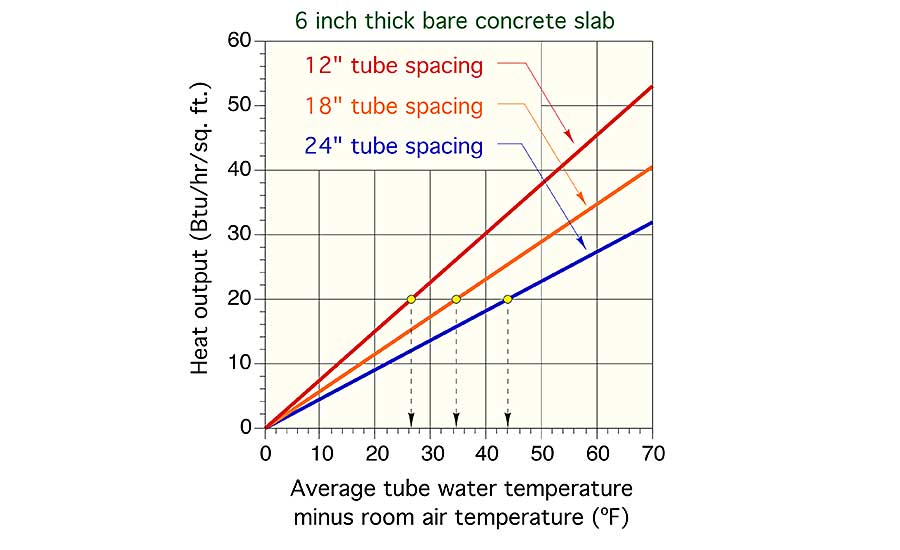
Assume the same building has a gypsum thin-slab with embedded tubing for heating the upper floor, and at design load, those circuits need 115° F average water temperature.
Increasing the tube spacing in the concrete slab portion of the system to 18 inches increases the average water temperature to about 104° F. Assuming a nominal 20° F circuit temperature drop under design load conditions, the supply temperatures for these circuits would be about 97+20/2=107° F and 104+20/2=114° F, respectively. These supply temperatures are within 10° F of each other and thus could very likely be supplied from the same system. In this case, the controls could be set to produce a supply temperature midway between these two values (around 110° F).
In this situation, one could also argue that it’s better to decrease the tube spacing on the higher temperature circuits and thus bring the average system water temperature down to promote efficiency gains at the heat source. This is a valid proposition for systems using mod/con boilers, geothermal heat pumps or solar collectors as heat sources. A life cycle cost comparison that factors in the changes in heat source efficiency versus the higher installation cost of more tubing could provide a substantiated answer to this point. However, when a conventional boiler is used, the changes in boiler efficiency will be very small, and the cost savings are mostly the result of not installing multiple mixing assemblies.
If variations in tube spacing aren’t enough, discuss the possibility of different flooring finish with the client before giving up on use of a single supply temperature.
I’ve found it possible to combine slab-on-grade systems with both thin-slabs and even underfloor tube and plate systems in certain circumstances. Eliminating the need for multiple mixing assemblies in these situations can reduce installation cost by hundreds of dollars.
When a single supply water temperature is possible, consider zoning manifolds using zone valves or individual circuits using valve actuators. Another possibility is to mix in non-electric thermostatic valves for zone control. This approach sets the stage for a simple delivery system using a single variable speed pressure regulated circulator. An example of such a “homerun” distribution system supplied by a mod/con boiler is shown in Figure 2.
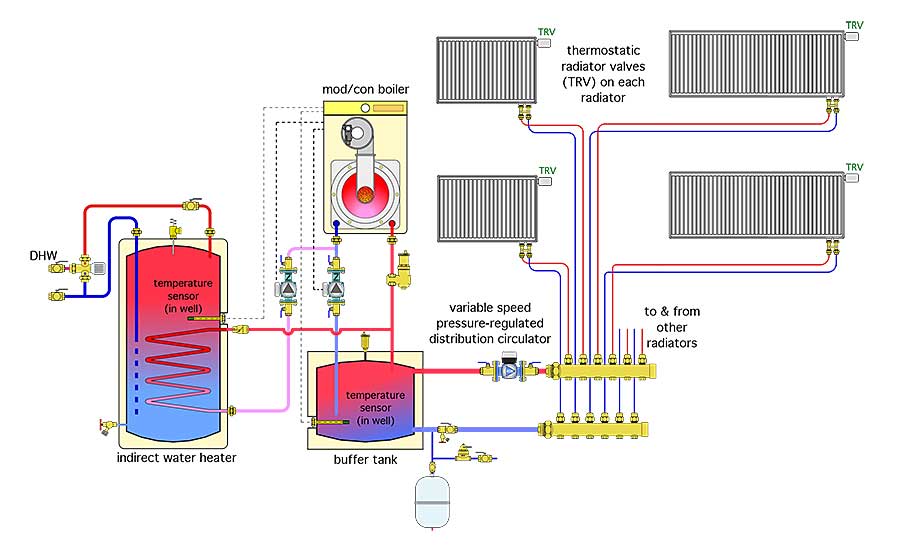
Fewer zones
The ability to divide a system in several independently controlled zones is one of the most cited benefits of hydronic heating. There are several techniques for providing multiple zones in almost any modern hydronic system. In most cases, zoning can be accomplished at a significantly lower cost than an equal number of zones in a forced air system.
However, just because you can set up every room in a building as a separate heating zone doesn’t mean you should.
This is especially true when installing wired zone controls. By the time all the transformers, valve actuators, relay centers and thermostats are connected, you may have installed a couple miles of thermostat cable, as shown in Figure 3. It’s tedious work that can easily add a couple thousand dollars to installed cost. Even when money isn’t an issue, all those thermostats may only be used to balance heat flow within the building rather than for continuous readjustment of temperature.
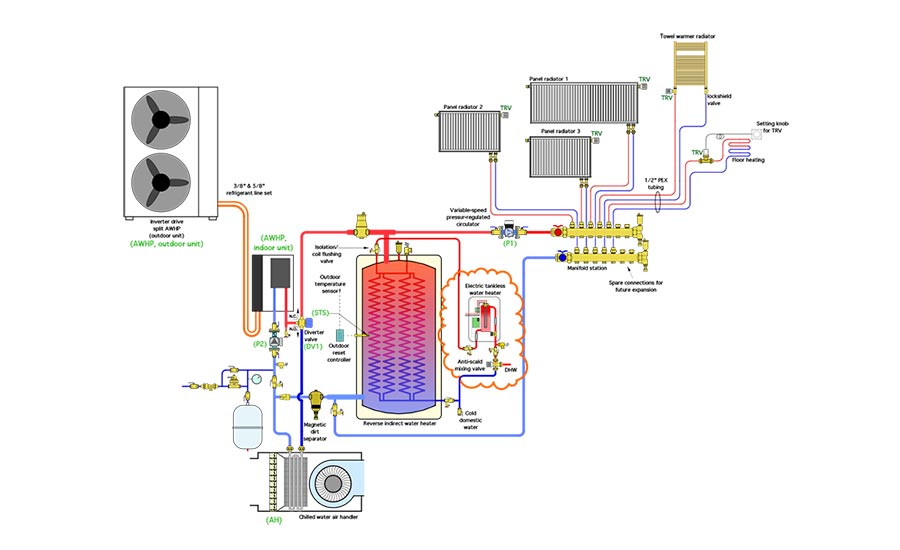
It’s important to not get carried away with “over-zoning.” When selecting zones, look for open areas in a building. Those areas “communicate” as far as heating is concerned, and seldom need to be on separate zones. Also look for areas that receive significant solar heat gain and put them on separate zones from non-solar gain areas.
If you really like the idea of room-by-room zone control take a good look at non-electric thermostatic valves. They’re available for use in baseboard and panel radiator systems as well as in wall-mounted boxes for site-built radiant panel systems. No wires and fully modulating control.
Less primary or secondary systems
Primary / secondary piping works. Over several years, we designed systems around this piping method. However, there are simpler and less expensive ways to achieve the benefits offered by P/S piping.
Figure 4 contrasts two approaches for achieving hydraulic separation of all circulators and equal supply water temperature to each load.
The system shown in Figure 4A uses a parallel primary loop to connect the boiler with each load. A dedicated primary circulator is required to move flow through the primary loop.
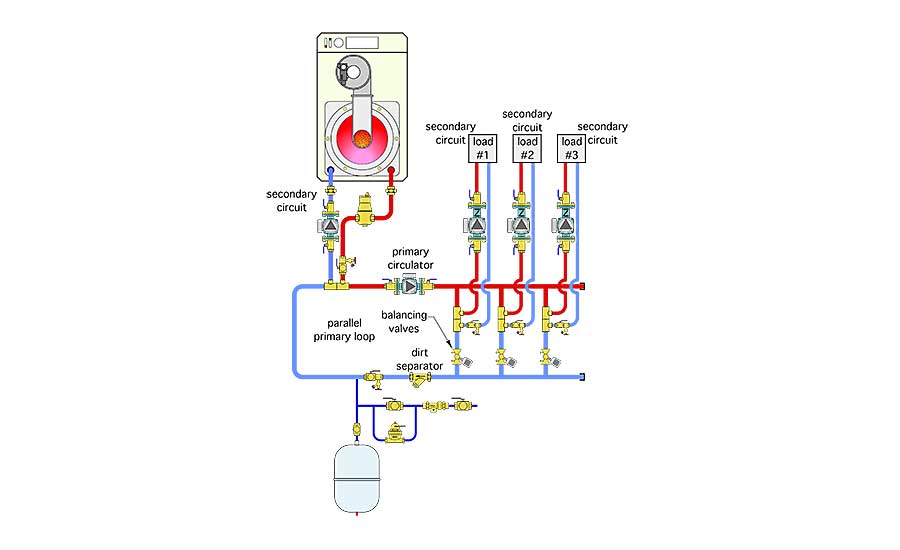
Figure 4B shows a system with a hydraulic separator replacing the primary loop. This eliminates the need of a primary circulator. It also eliminates the need for a dedicated air and dirt separators, since these functions are handled by the internal coalescing media in the hydraulic separator.
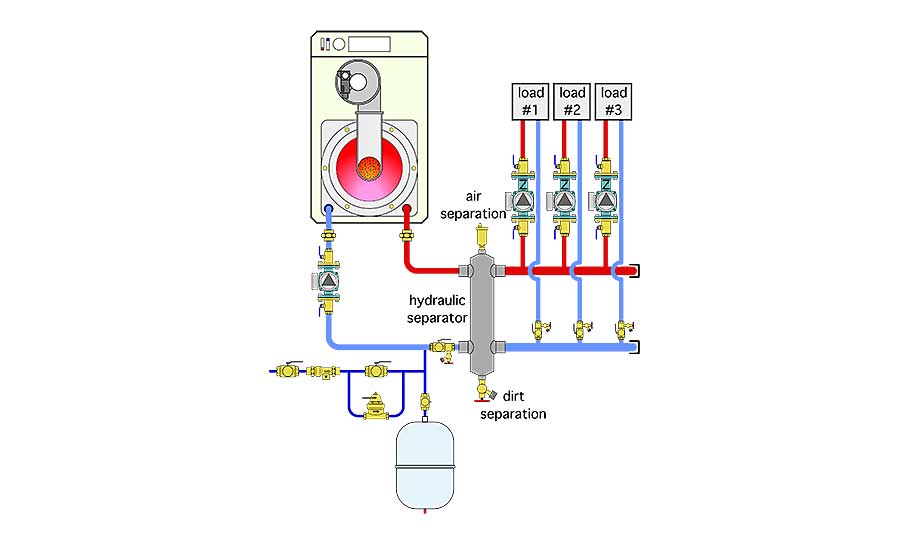
Fewer transformers
Have you ever been in a mechanical room where there’s a half dozen or more transformers mounted on 4x4 J-boxes and buzzing away 24/7? Figure 5 (on page 70) shows an example of such a situation. There’s a transformer located within each of those red clouds.
Put your hand on any active transformer and it feels warm. That’s because it’s sitting there converting electricity into heat through its primary windings regardless of whether there is an active load on its secondary winding. The installed cost of multiple transformers is certainly more than the transformers themselves. Each needs a J-box and associated wiring. Multiple transformers also set the stage for problems if connected in parallel without proper “phasing.”
Consider using a single larger transformer, such as one with a 100 VA rating, rather than several smaller transformers. Use control arrangements that turn off transformers when the portion of the system they serve is not needed. The electrical energy you save through reductions in control transformers is probably not going to be huge, but every bit helps.
Less antifreeze
I have a saying about antifreeze: “The only good thing about antifreeze is it doesn’t freeze.” Glycol-based antifreeze decreases the heat capacity of the fluid relative to water. This requires increased flow rate for the same heat conveyance. The higher viscosity of glycol-based antifreeze also adds significantly to head loss. At 120° F, a 50% solution of propylene glycol increases head loss (at the same flow rate) by about 24%. When the flow rate is increased to compensate for reduced heat capacitance, the head loss goes up by 47%! That translates in more pumping power and higher operating cost.
As many of you have discovered, glycol-based antifreeze also has a propensity to weep through threaded fitting joints and create surface oxidation where water would either not leak or quickly evaporate without scaling. Last, but not least, filling a system with a 50% glycol solution can easily add a few hundred bucks to installed cost.
So, where should antifreeze be used? Snow-melting systems, and closed loop solar collectors obviously need the protection it offers. In Northern climates, we also specify glycol in residential garage heating circuits, and in homes that will be unoccupied for several consecutive winter days.
We used to specify antifreeze for floor heating systems in large slab-on-grade facilities such as highway garages. However, many of these buildings now have emergency generators that can keep running during a prolonged power outage. With constant circulation ”stirring” heat around in a large concrete slab, it could take several cold days before water in the slab circuits would be in danger of freezing, even if the boiler was not operating. Given these favorable odds, we now avoid antifreeze in this type of facility.
Why less is more
It’s always a bit precarious to write about hardware being removed from systems. That hardware produces income for its manufacturer right down to the professional who installs it.
My suggestions are in the interest of reducing cost without compromising quality, as well as removing some of the stigma of over-complexity that hydronic systems seem to have developed in the eyes of many architects, builders, energy planners and consumers. We want to build market share not parts count. Why build a 777 Dreamliner when our clients need a Piper Cub?




